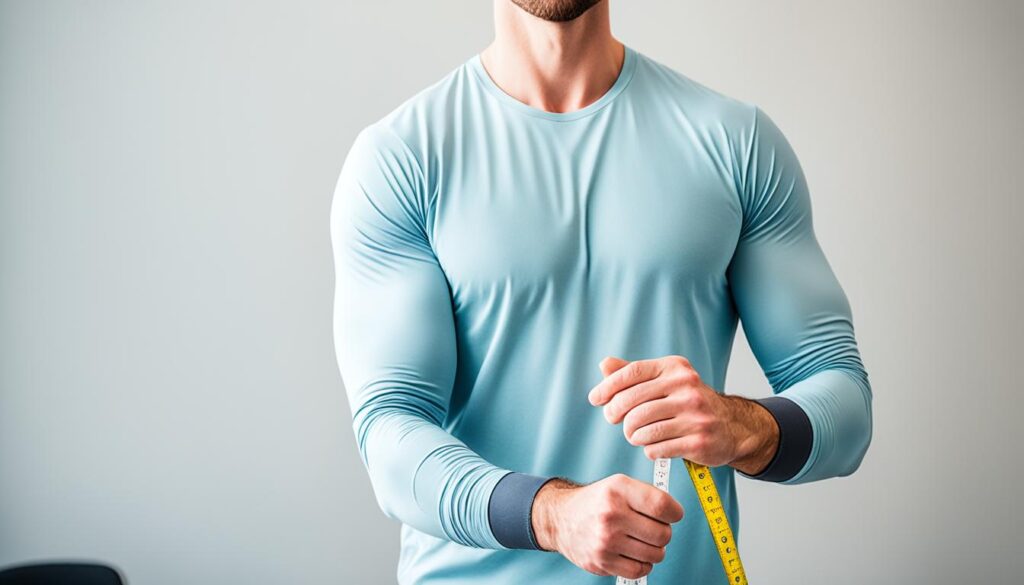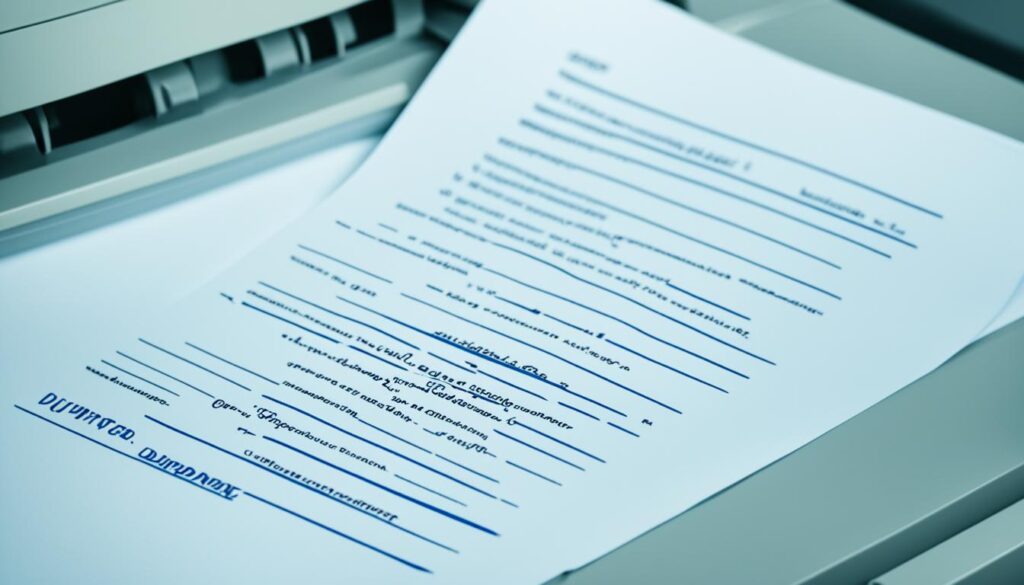When it comes to donning a stylish shirt, have you ever considered that the secret to the perfect fit might lie in the understanding of how to measure sleeve length? It’s a detail that many overlook, yet it’s the cornerstone of a tailored appearance. The length of your sleeves is not just about your arm’s reach; it encompasses the shoulder construction and the shirt’s armhole as well. Our comprehensive sleeve length measurement guide is about to change the way you think about fitting into your shirts, ensuring each one looks like it was custom-made for you.
While you might assume this measurement starts at your shoulder, the best way to measure sleeve length actually begins at the center of your back, right at the nape of your neck. This method addresses the various shoulder shapes and sizes, providing an end result that accounts for movement and comfort without the need for troublesome adjustments post-wash. Designers take these factors into account, so you won’t have to. Curious to know more about measuring sleeve length for shirts? Let’s dive in!
Key Takeaways
- Discover the starting point for sleeve measurement to ensure a bespoke fit.
- Understand how shoulders and armholes impact your sleeve length.
- Learn why measuring from the center of the back provides a more accurate portrayal of sleeve length for shirts.
- Explore factors to consider when measuring sleeve length beyond arm’s length.
- Gain tips to account for shrinkage and find the true sleeve length.
Understanding the Basics of Sleeve Measurement
When it comes to perfecting your style, knowing the proper sleeve length measurement plays a significant role in achieving a tailored appearance. Aspects such as sleeve length sizing and sleeve length measurement tips are essential to grasp to avoid common fashion faux pas. Let’s delve into the fundamentals that will elevate your fashion acumen.
The Importance of Proper Sleeve Length
To exude elegance and maintain comfort, the proper sleeve length is vital. It’s not merely a matter of arm length; you must consider the shoulder width, and the positioning of the shoulder seam affect how the sleeve drapes on your body. A flawlessly measured sleeve length ensures your cuffs will sit at just the right point on your wrist—allowing for ease of movement while keeping the lines of your shirt crisp and professional.

Sleeve Measurement Vs. Arm Length: Knowing the Difference
The common misconception that sleeve length equates to arm length can lead you astray. True proper sleeve length measurement begins from the nape of the neck and extends over the shoulder, following the arm down to just past the wrist bone for formal wear. On the other hand, casual wear might only consider the arm’s length from shoulder to wrist. Remembering this distinction is a crucial element of sleeve length sizing, as it affects the final fit and feel of your garments.
Adhering to these sleeve length measurement tips can be your stepping stone to a more polished wardrobe where comfort meets style, and you never have to second-guess the fit of your sleeves again.
How to Measure Sleeve Length
A Step-by-Step Approach
Finding the right sleeve length is vital to achieving a tailored and sophisticated look. The best way to measure sleeve length includes a seamless integration of various steps to ensure precision and comfort. Below we guide you through the anatomy of measuring sleeve length, effectively combining practicality with ease.
Finding the Starting Point: Measuring from the Back of the Neck
Your journey to the perfect sleeve length begins with identifying the nape of your neck. Place your measuring tape at the center point, aligning with your spine as the foundation of an accurate measurement. This initiates the sleeve length chart you will follow.
Over the Shoulder: Getting the Right Curve
With the start point established, transition the measuring tape over your shoulder, tracing the natural curve and ensuring the tape lies smoothly over the fabric of what you wear. This portion of the measurement acknowledges how important the drop of your shoulder is to the best way to measure sleeve length.
Down to the Wrist: Ensuring Precise Length
Continuing from the curve of your shoulder, guide the tape down your arm. Subtly bend your elbow to mirror the arm’s natural resting position to capture a length that accommodates necessary movement. Stop at the point where you expect your shirt cuff to sit, just at the wrist bone. For the most formal and bespoke fit, rounding to the nearest half inch gives that custom-tailored precision that makes all the difference.

Now, let’s look at an example sleeve length chart to help visualize how different measurements correlate:
| Shirt Size | Neck (in) | Sleeve Length (in) |
|---|---|---|
| Small | 14-14.5 | 32-33 |
| Medium | 15-15.5 | 33-34 |
| Large | 16-16.5 | 34-35 |
| X-Large | 17-17.5 | 35-36 |
| XX-Large | 18-18.5 | 36-37 |
Achieving ideal fit necessitates individualized measurements, as sizes and styles dictate sleeve length. Use this guide and chart as a template, but don’t shy away from measuring each garment specifically for the best way to measure sleeve length. With the precise figures in hand, stepping out in confidence, knowing your shirts are fitted perfectly to you, will be your new norm.
Adjusting for Different Sleeve Types and Styles
When determining your sleeve length measurement, it’s crucial to account for various styles and preferences that impact the final fit of a garment. The intricate process of measuring sleeve length is more nuanced than it initially appears, as it involves not only length but also width to ensure maximum comfort and impeccable style.
Different sleeve types, whether they’re tailored for casual wear or formal attire, may necessitate tailored adjustments to provide an ideal fit. This distinction is particularly important when dealing with fitted sleeves versus those with a looser design. You’ll need to measure the circumference at several points, including the bicep, the elbow, and the wrist to create a properly fitting sleeve.
These measurements must include an additional 1-2 inch allowance for both ease of movement and the inclusion of seams. This ensures the sleeve length measurement gives you enough fabric for a comfortable and flattering fit across the arm.
To accurately adjust sleeve patterns to your measuring sleeve length, mark the distance from the shoulder to the wrist, ensuring to note the depth of the armhole. It’s this attention to detail that accommodates different sleeve types and ensures that the sleeve connects seamlessly with the body of the garment.
Mastery in sleeve fitting requires understanding the shape of the shoulder curve and armhole. Every individual’s measurements are unique, and their patterns should reflect this. As you tailor the pattern for your sleeves, make sure to revise the width and shape to match your specific arm dimensions, from the broader section of the bicep tapering down to the wrist. This customization step is vital to avoid any tightness or excessive looseness that could lead to discomfort or a less-than-desirable appearance.
Remember, the key to a well-fitted sleeve is in the details. By being thorough in your sleeve length measurement and allowing for slight variations, you not only ensure comfort but also uphold the garment’s style, giving you the polished look that comes with custom-tailored clothing.
Pro Tips for Accurate Sleeve Length Sizing
Embarking on the quest for the perfect fit means paying close attention to sleeve length measurement tips. Ensuring a proper sleeve length measurement is not just about aesthetic—it’s about comfort and personal style. Whether you’re measuring for an upcoming event or simply refining your everyday wear, mastering these measuring techniques can be done even without an assistant.
Measuring Without a Helper: Tricks for Solo Measuring
When you find yourself solo during the measuring process, using your knowledge of proper sleeve length measurement is key. Start by bending your arm at a right angle, as if you were checking your watch. This position allows you to take into account any movements you will make while wearing the garment. Next, use a flexible measuring tape to measure from the center back of your neck, over your shoulder, and down to your wrist, marking the point where you would like your sleeve to end.
Considering Shoulder and Armhole Shapes for a Perfect Fit
As you embark on your sleeve length measurement journey, remember that the shape of your shoulder and armhole is paramount for that perfect fit. To ascertain this, stand naturally and measure your shoulder width from the center of the back. This will help you determine whether you have broad or narrow shoulders and the corresponding armhole cut you need. In conjunction with these sleeve length measurement tips, wrap the tape around your chest to find the armhole size that will afford you both comfort and a silhouette that compliments your body.
By prioritizing these proper sleeve length measurement strategies, you’re well on your way to acquiring a perfectly fitted sleeve, enhancing not just the look but also the feel of your apparel. Armed with these pro tips and careful attention to detail, your garments will boast a tailored precision that’s unmistakably yours.
Conclusion
Mastering how to measure sleeve length is a skill that paves the way for a wardrobe filled with impeccably fitting men’s dress shirts. This comprehensive sleeve length measurement guide empowers you to take the reins when it comes to personal style and comfort. Precise and careful measuring sleeve length is the cornerstone of achieving that tailor-made look, essential for enhancing your overall appearance.
Rounding your measurements to the nearest half or full inch is recommended for sleeve length for shirts, ensuring a polished silhouette. It’s important to note that sleeve length requirements will vary depending on clothing types. Whenever you feel uncertain about the measurements you have taken, measuring the specific garment again or opting for professional alterations can ensure the perfect fit.
Armed with the knowledge from this guide, you are now well-prepared to select dress shirts with assurance and understand the value of a well-fitted sleeve. This is not just about precision in sizing but about recognizing the profound impact that such details have on the overall aesthetics of your attire. With these skills, the fashion world is yours to tailor to your unique shape and style.

